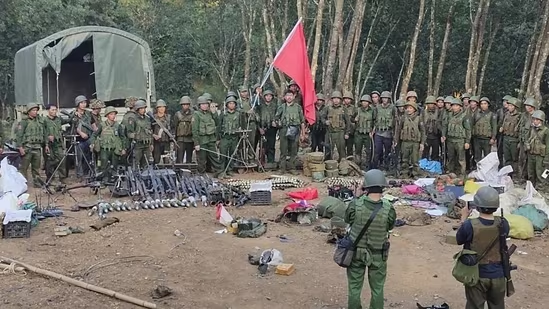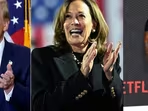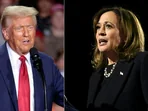Myanmar's armed rebellion against the junta over the years
On October 27, an ethnic armed organisation (EAO) based in Myanmar’s north began fierce coordinated operations against military regime targets with two other groups. The Myanmar National Democratic Alliance Army (MNDAA), also known as the ‘Kokang army’, led the blitzkrieg from the front alongside the Ta’ang National Liberation Army (TNLA) and the Arakan Army (AA). The junta, which snatched power from a civilian government in a coup in February 2021, was left stunned as the alliance made rapid territorial gains across northern Shan State, including in areas along the Sino-Myanmar border.
 PREMIUM
PREMIUM Ironically, the MNDAA was the first ethnic army to have signed a bilateral ceasefire agreement with the Myanmar military in 1989 when the Communist Party of Burma (CPB) collapsed and splintered into several smaller ethnic groups. Who would have thought it would go on to stage the most formidable assault against the same military more than three decades later? But, those watching the absurd twists and turns of modern Burmese history closely won’t find this surprising.
The MNDAA’s ceasefire unravelled exactly 20 years after it was signed when the then-junta chased it out of its home city of Laukkaing in a ferocious offensive in 2009. The man leading that military campaign against the Kokang army was Min Aung Hlaing – the current junta chief. Hlaing made his mark in that campaign as a regional commander, standing out as a man fit for promotion to the highest ranks. Today, even as the MNDAA and its compatriots rapidly advance towards Laukkaing, Hlaing stares at a dramatic turn of fate.
The joint ethnic offensive against the junta, christened “Operation 1027”, is unprecedented. Yet, this is not the first time the three northern groups have attacked the military together. They did so even before the 2021 coup — once in 2016 and then again in 2019. However, Operation 1027 has proven to be different in scope and outcome.
For one, this time, the 3BA has captured large swathes of territory, including urban centres and border towns, and dozens of regime bases. Hundreds of soldiers, including one full battalion, have surrendered without a fight. Further, the whole operation is unfolding in tandem with the “Spring Revolution”, a larger countrywide movement against the junta that began right after the 2021 putsch. The 3BA has harmonised its messaging with the vision and objectives of the national revolution. They have also been silently training and arming some of the smaller, newer anti-junta groups, known as “People’s Defence Forces (PDF)”, and exchanging notes with other well-established ethnic armies in western and eastern Myanmar.
It is, therefore, no surprise that other EAOs and multi-ethnic PDFs are now staging synchronised offensives against junta targets in eastern, western and southwestern Myanmar. This marks a historic coming together of majority Bamar and minority non-Bamar blocs to fight a common national enemy. Bamars, also known as “Burmans”, are a Sino-Tibetan, mostly Buddhist ethnic group which constitutes the majority among the 135 recognised ethnic groups in Myanmar. Historically, they have commanded strong political and cultural influence in Burma as monarchical rulers and political elites.
While this difficult quest for unity has coloured most of Myanmar’s postcolonial ethno-politics, history reveals that the desire to create a unified front against the Generals has always run deep in the country’s political veins.
In the late summer of 1988, massive protests erupted across Myanmar against General Ne Win’s junta. The regime wasted no time in brutally crushing the demonstrations, slaughtering thousands. Yet, the movement, now known as the ‘8888 Uprising’, revealed the first signs of inter-ethnic unity.
As veteran Myanmar watcher, Bertil Lintner, writes in Burma in Revolt, “communal friction and old grudges were forgotten and, maybe for the first time ever, all national and political groups across the country joined together for a common cause.” While the unity did not translate into military cooperation, the memory of 8888 has endured in Burmese revolutionary politics.
Operation 1027 lends a new meaning to Linter’s words, reminding us that despite all its fractures, Myanmar’s desire for democracy and federalism cuts across ethnic lines.
The lack of majority-minority unity across Myanmar’s history, however, should not be equated with a total lack of any kind of cooperation. Ethnic armed groups have routinely joined forces to mount a common fight against successive central regimes. The 3BA, in that sense, is premised on a rich legacy of inter-ethnic collaboration.
A short history lesson
In the decades following independence from British colonial rule, most of the ethnic armies fought Rangoon in their own silos. Even after the bloody 1962 coup (led by General Ne Win, against the government of Prime Minister U Nu), they continued to operate autonomously. At times, they even sparred with each other over territory and resources. For example, when a large and well-armed contingent of the CPB swept across the Sino-Myanmar border in January 1968, it faced the KIA’s wrath in some areas.
But, signs of inter-ethnic unity began to surface soon after. By 1975, seven ethnic rebel coalitions had emerged, although none of them was potent. It was then that 13 EAOs came together under the leadership of the Karen National Union (KNU) to form the National Democratic Front (NDF) in Manerplaw, Karen State. In 1992, the NDF floated its own charter for a federal Burma – again, not without historical precedent.
On the cusp of Burma’s independence from British colonial rule, the Shans, Kachins, and Chins — three large minority ethnic groups — signed the “Panglong Agreement” with the Bamar nationalist leadership led by General Aung San, the father of Aung San Suu Kyi whose hybrid civil-military government was overthrown in 2021. It promised autonomy and dignity to the ethnic minorities, creating the first-ever framework for a federal democratic union. But, the “Panglong spirit” died even before it could be born, as the Bamar leadership failed to stick to its promises.
The 1992 Manerplaw charter was an attempt to revive the Panglong dream. However it failed to foster long-lasting inter-ethnic unity as the junta used brute force against the armed groups while simultaneously engineering lucrative ceasefire deals with them. This does not, however, mean that the era of ethnic coalitions was over. In fact, the most formidable ones were yet to come. Such has been the temperamental nature of modern Burmese history.
A sort of democracy in more recent times
Beginning in 2010, the military allowed a quasi-civilian government to partially take over affairs of the state and floated the Nationwide Ceasefire Agreement (NCA). It was an open offer to the EAOs to start talking to the Aung San Suu Kyi-led union government and the military. But, the northern groups saw it as the military’s ploy to permanently disarm them. So, they refused to sign it, even as eight others from around the country did, including the powerful Chin National Front (CNF) and the KNU.
Instead, they banded together to create three EAO collectives — the four-member “Northern Alliance”, the seven-member Federal Political Negotiation and Consultative Committee (FPNCC), and finally, the 3BA behind the ongoing Operation 1027. In 2017, reviving the long-lost Manerplaw dream, the FPNCC published its own charter for a federal democratic union. This offered an alternative vision for a new Myanmar that challenged the Bamar-centric politics of the military and Suu Kyi government.
Cut to the present. Not only is the FPNCC going strong, emerging as a standalone power centre in the north, but its federal vision has now entered the national mainstream. In late 2021, elected civilian lawmakers released the ‘Federal Democracy Charter (FDC)’ — a detailed vision for the majority and minority to share power on equal terms. What was once the manifesto of a select group of ethnic armed organisations has today become a national revolutionary goal.
Moreover, while the 3BA now seems to be the most effective anti-junta military alliance in all of Myanmar, it isn’t the only one. Even the CNF and KNU have been coordinating combat strategies as part of a tripartite tactical alliance with the influential Kachin Independence Army (KIA), known as the “K3C”. Add to this the emerging coordination between various EAOs and the National Unity Government (NUG). While some ethnic blocs see the NUG (formed after the 2021 coup) as a Bamar-dominated formation, that might be changing as a united front emerges.
In the statements published after Op 1027 began, the 3BA has stated its intent to overthrow junta rule. If the alliance is to succeed, we would most likely see a rainbow coalition come to power that is nationally led by the NUG, but also gives strong political autonomy to local parties/groups, including the EAOs.
What’s more, there are unarmed strike committees, CSOs and civil disobedience groups, but all of them overwhelmingly support the armed struggle. This proves that we are witnessing a uniquely comprehensive revolution in Myanmar today.
This rich tapestry of inter-group cooperation is anchored in history, and yet, portends a new future for Myanmar. It is this profound continuity from the past to the present that will shape Burmese nation-building in the years to come. The “what ifs” of history could soon become the reality of the future.
Angshuman Choudhury is an Associate Fellow at the Centre for Policy Research, New Delhi.
Continue reading with HT Premium Subscription
Daily E Paper I Premium Articles I Brunch E Magazine I Daily Infographics Subscribe Now @1199/year Already Subscribed? Sign In
Disclaimer: The copyright of this article belongs to the original author. Reposting this article is solely for the purpose of information dissemination and does not constitute any investment advice. If there is any infringement, please contact us immediately. We will make corrections or deletions as necessary. Thank you.
Title:Myanmar's armed rebellion against the junta over the years
Url:https://www.investsfocus.com









